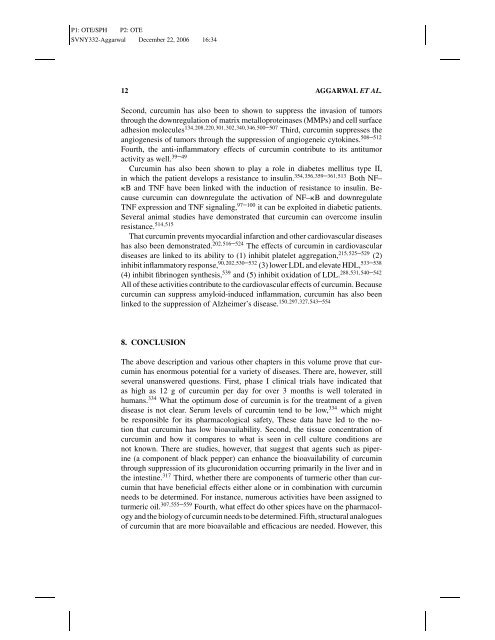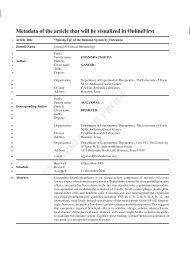CURCUMIN: THE INDIAN SOLID GOLD
CURCUMIN: THE INDIAN SOLID GOLD
CURCUMIN: THE INDIAN SOLID GOLD
Create successful ePaper yourself
Turn your PDF publications into a flip-book with our unique Google optimized e-Paper software.
P1: OTE/SPH P2: OTE<br />
SVNY332-Aggarwal December 22, 2006 16:34<br />
12 AGGARWAL ET AL.<br />
Second, curcumin has also been to shown to suppress the invasion of tumors<br />
through the downregulation of matrix metalloproteinases (MMPs) and cell surface<br />
adhesion molecules 134,208,220,301,302,340,346,500–507 Third, curcumin suppresses the<br />
angiogenesis of tumors through the suppression of angiogeneic cytokines. 508–512<br />
Fourth, the anti-inflammatory effects of curcumin contribute to its antitumor<br />
activity as well. 39–49<br />
Curcumin has also been shown to play a role in diabetes mellitus type II,<br />
in which the patient develops a resistance to insulin. 354,356,359–361,513 Both NF–<br />
B and TNF have been linked with the induction of resistance to insulin. Because<br />
curcumin can downregulate the activation of NF–B and downregulate<br />
TNF expression and TNF signaling, 97–100 it can be exploited in diabetic patients.<br />
Several animal studies have demonstrated that curcumin can overcome insulin<br />
resistance. 514,515<br />
That curcumin prevents myocardial infarction and other cardiovascular diseases<br />
has also been demonstrated. 202,516–524 The effects of curcumin in cardiovascular<br />
diseases are linked to its ability to (1) inhibit platelet aggregation, 215,525–529 (2)<br />
inhibit inflammatory response, 90,202,530–532 (3) lower LDL and elevate HDL, 533–538<br />
(4) inhibit fibrinogen synthesis, 539 and (5) inhibit oxidation of LDL. 288,531,540–542<br />
All of these activities contribute to the cardiovascular effects of curcumin. Because<br />
curcumin can suppress amyloid-induced inflammation, curcumin has also been<br />
linked to the suppression of Alzheimer’s disease. 150,297,327,543–554<br />
8. CONCLUSION<br />
The above description and various other chapters in this volume prove that curcumin<br />
has enormous potential for a variety of diseases. There are, however, still<br />
several unanswered questions. First, phase I clinical trials have indicated that<br />
as high as 12 g of curcumin per day for over 3 months is well tolerated in<br />
humans. 334 What the optimum dose of curcumin is for the treatment of a given<br />
disease is not clear. Serum levels of curcumin tend to be low, 334 which might<br />
be responsible for its pharmacological safety, These data have led to the notion<br />
that curcumin has low bioavailability. Second, the tissue concentration of<br />
curcumin and how it compares to what is seen in cell culture conditions are<br />
not known. There are studies, however, that suggest that agents such as piperine<br />
(a component of black pepper) can enhance the bioavailability of curcumin<br />
through suppression of its glucuronidation occurring primarily in the liver and in<br />
the intestine. 317 Third, whether there are components of turmeric other than curcumin<br />
that have beneficial effects either alone or in combination with curcumin<br />
needs to be determined. For instance, numerous activities have been assigned to<br />
turmeric oil. 307,555–559 Fourth, what effect do other spices have on the pharmacology<br />
and the biology of curcumin needs to be determined. Fifth, structural analogues<br />
of curcumin that are more bioavailable and efficacious are needed. However, this



